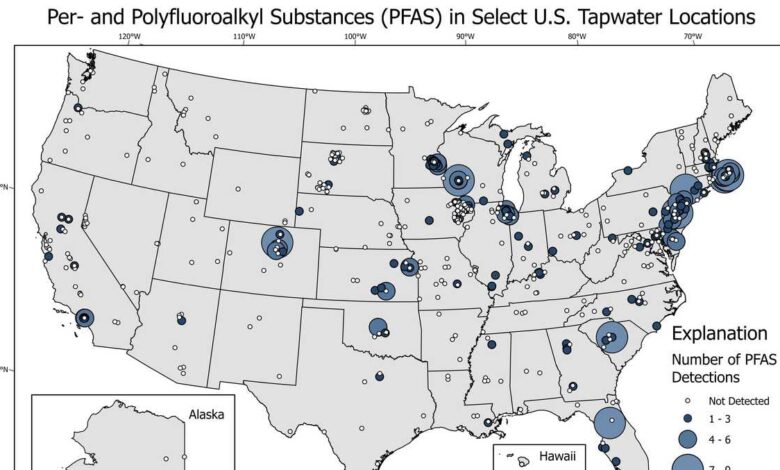
Almost half of the tap water in the United States is contaminated with chemicals known as "forever chemicals," according to a new study from the U.S. Geological Survey.Video above: What are harmful 'forever chemicals' and how can they make you sickThe number of people drinking contaminated water may be even higher than what the study found, however, because the researchers weren't able to test for all of these per- and polyfluorinated alkyl substances, or PFAS, chemicals that are considered dangerous to human health.PFAS are a family of ubiquitous synthetic chemicals that linger in the environment and the human body. PFAS exposure is linked to problems like cancer, obesity, thyroid disease, high cholesterol, decreased fertility, liver damage and hormone suppression, according to the U.S. Environmental Protection Agency.In June 2022, based on the latest science, the EPA issued health advisories that said the chemicals are much more hazardous to human health than scientists originally thought and are probably more dangerous even at levels thousands of times lower than previously believed.There are more than 12,000 types of PFAS in total, according to the National Institutes of Health, but only 32 of the compounds can be picked up by lab tests developed by the U.S. Geological Survey.Previously, there was limited information on exactly how much PFAS chemicals are in residential tap water, said the authors of the research, published Wednesday in the journal Environmental International. They added that this study is the most comprehensive to date that includes both private wells and public water sources.The scientists collected water samples directly from taps at 716 locations – 269 from private wells and 447 from public sources – between 2016 and 2021. Based on their findings, they estimate that at least one PFAS chemical would be detected in 45% of U.S. drinking water samples.Most of the contamination came from water sources near urban areas and in areas that generated PFAS, like manufacturing that uses the chemicals in its products or sites where waste was collected.The highest concentrations of PFAS in drinking water were found in the Great Plains, the Great Lakes, the Eastern Seaboard and Central/Southern California, the study said.Concentrations were similar between private wells and public supplies.PFAS can be found in many places, studies show, so toxicologist Dr. Jamie DeWitt is not surprised that it is in so much drinking water."There's been almost no place scientists have looked where they have not found PFAS," said DeWitt, a professor of pharmacology and toxicology in the Department of Pharmacology & Toxicology at East Carolina University who was not involved in the new study.PFAS are found in hundreds of household items. The chemicals are used to make carpets and clothes stain-resistant. They keep food from sticking to pans and food packaging, and they're good at keeping grease and water from soaking through. PFAS are in mobile phones, commercial airplanes and low-emission vehicles, in the foods you can buy at the farmers market or the grocery store, and in rainwater and dental floss. They're even in the dust that collects in your home.A 2019 study suggested that PFAS chemicals could be found in 98% of the U.S. population. With that in mind, the new 45% number may sound low, but DeWitt said there could be a couple of factors at play. For one, a number of utilities have been making an effort to remove PFAS from the water. Homeowners could also have filters on their systems that make it so PFAS are not as easily detectable."I think that's still a pretty high number, considering," she said.DeWitt said that it's important for people to know what’s in their drinking water but that they don't necessarily need to be scared."I don't think people should be afraid, but they should be aware and armed themselves with knowledge so that they can get information that will help them to make decisions," she said.She recommended looking at your local utility website to get its most recent water report. Utilities will disclose what’s in the water and what they are doing to reduce contaminants.A carbon filter can help, but it has to be changed regularly. If used too long, the filter can become saturated with chemicals and not work as well. Households can also use reverse osmosis filtering systems, but those can be expensive.The EPA has proposed the first national drinking water standards for six PFAS chemicals. The proposed limits set the allowable levels for these chemicals so low that they could not be easily detected.If the standards are finalized, water systems will have to determine whether levels of these PFAS pose a potential risk. They may also need to install treatment or take other actions, the EPA said, and may even need to switch to different water sources.If PFAS is in 45% of U.S. water systems, the country will have a lot of work to do, said Dr. Graham Peaslee, a professor in the Department of Physics and Astronomy and concurrent professor of chemistry and biochemistry who does PFAS research at the University of Notre Dame."I think that we should try our best to work on how to clean this up. My fear is that this is, global warming aside, this is probably the most expensive environmental problem we're ever going to face," said Peaslee, who was not involved in the new study. "There's nothing that will magically fix it. It's fairly expensive to clean this up. And it's a recurring cost, and there's no permanent solution to it for any particular utility. It looks frightening."But the cleanup will have to be done, he said, because these chemicals carry real health consequences, and people can't exactly avoid drinking water."It's really insidious, this poison," Peaslee said. "We are going to have to get inventive on how to filter it out for all of our days."
Almost half of the tap water in the United States is contaminated with chemicals known as "forever chemicals," according to a new study from the U.S. Geological Survey.
Video above: What are harmful 'forever chemicals' and how can they make you sick
The number of people drinking contaminated water may be even higher than what the study found, however, because the researchers weren't able to test for all of these per- and polyfluorinated alkyl substances, or PFAS, chemicals that are considered dangerous to human health.
PFAS are a family of ubiquitous synthetic chemicals that linger in the environment and the human body. PFAS exposure is linked to problems like cancer, obesity, thyroid disease, high cholesterol, decreased fertility, liver damage and hormone suppression, according to the U.S. Environmental Protection Agency.
In June 2022, based on the latest science, the EPA issued health advisories that said the chemicals are much more hazardous to human health than scientists originally thought and are probably more dangerous even at levels thousands of times lower than previously believed.
There are more than 12,000 types of PFAS in total, according to the National Institutes of Health, but only 32 of the compounds can be picked up by lab tests developed by the U.S. Geological Survey.
Previously, there was limited information on exactly how much PFAS chemicals are in residential tap water, said the authors of the research, published Wednesday in the journal Environmental International. They added that this study is the most comprehensive to date that includes both private wells and public water sources.
The scientists collected water samples directly from taps at 716 locations – 269 from private wells and 447 from public sources – between 2016 and 2021. Based on their findings, they estimate that at least one PFAS chemical would be detected in 45% of U.S. drinking water samples.
Most of the contamination came from water sources near urban areas and in areas that generated PFAS, like manufacturing that uses the chemicals in its products or sites where waste was collected.
The highest concentrations of PFAS in drinking water were found in the Great Plains, the Great Lakes, the Eastern Seaboard and Central/Southern California, the study said.
Concentrations were similar between private wells and public supplies.
PFAS can be found in many places, studies show, so toxicologist Dr. Jamie DeWitt is not surprised that it is in so much drinking water.
"There's been almost no place scientists have looked where they have not found PFAS," said DeWitt, a professor of pharmacology and toxicology in the Department of Pharmacology & Toxicology at East Carolina University who was not involved in the new study.
PFAS are found in hundreds of household items. The chemicals are used to make carpets and clothes stain-resistant. They keep food from sticking to pans and food packaging, and they're good at keeping grease and water from soaking through. PFAS are in mobile phones, commercial airplanes and low-emission vehicles, in the foods you can buy at the farmers market or the grocery store, and in rainwater and dental floss. They're even in the dust that collects in your home.
A 2019 study suggested that PFAS chemicals could be found in 98% of the U.S. population. With that in mind, the new 45% number may sound low, but DeWitt said there could be a couple of factors at play. For one, a number of utilities have been making an effort to remove PFAS from the water. Homeowners could also have filters on their systems that make it so PFAS are not as easily detectable.
"I think that's still a pretty high number, considering," she said.
DeWitt said that it's important for people to know what’s in their drinking water but that they don't necessarily need to be scared.
"I don't think people should be afraid, but they should be aware and armed themselves with knowledge so that they can get information that will help them to make decisions," she said.
She recommended looking at your local utility website to get its most recent water report. Utilities will disclose what’s in the water and what they are doing to reduce contaminants.
A carbon filter can help, but it has to be changed regularly. If used too long, the filter can become saturated with chemicals and not work as well. Households can also use reverse osmosis filtering systems, but those can be expensive.
The EPA has proposed the first national drinking water standards for six PFAS chemicals. The proposed limits set the allowable levels for these chemicals so low that they could not be easily detected.
If the standards are finalized, water systems will have to determine whether levels of these PFAS pose a potential risk. They may also need to install treatment or take other actions, the EPA said, and may even need to switch to different water sources.
If PFAS is in 45% of U.S. water systems, the country will have a lot of work to do, said Dr. Graham Peaslee, a professor in the Department of Physics and Astronomy and concurrent professor of chemistry and biochemistry who does PFAS research at the University of Notre Dame.
"I think that we should try our best to work on how to clean this up. My fear is that this is, global warming aside, this is probably the most expensive environmental problem we're ever going to face," said Peaslee, who was not involved in the new study. "There's nothing that will magically fix it. It's fairly expensive to clean this up. And it's a recurring cost, and there's no permanent solution to it for any particular utility. It looks frightening."
But the cleanup will have to be done, he said, because these chemicals carry real health consequences, and people can't exactly avoid drinking water.
"It's really insidious, this poison," Peaslee said. "We are going to have to get inventive on how to filter it out for all of our days."
Source link









